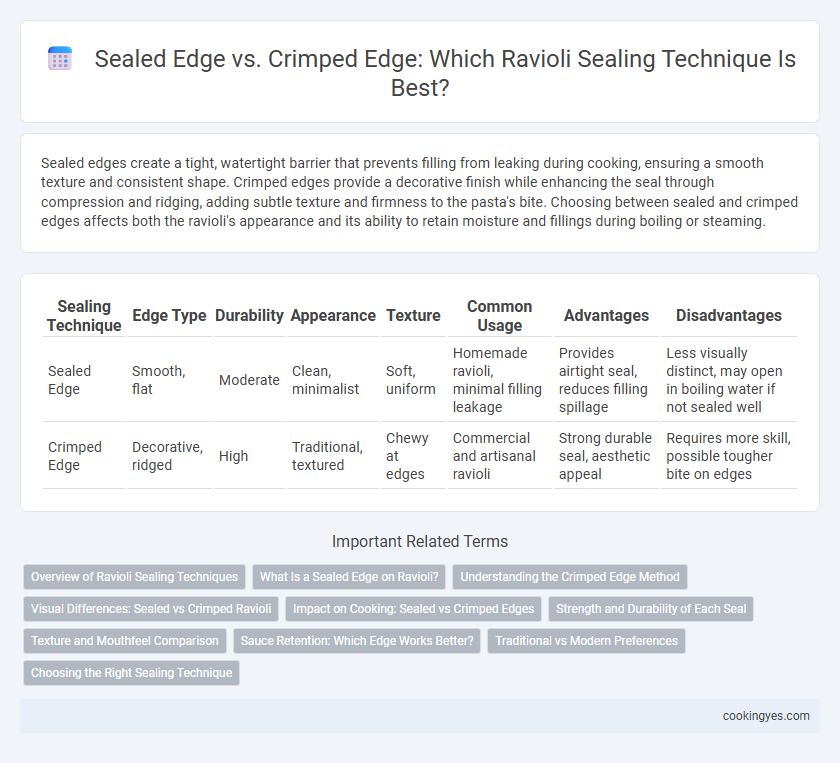Sealed edges create a tight, watertight barrier that prevents filling from leaking during cooking, ensuring a smooth texture and consistent shape. Crimped edges provide a decorative finish while enhancing the seal through compression and ridging, adding subtle texture and firmness to the pasta's bite. Choosing between sealed and crimped edges affects both the ravioli's appearance and its ability to retain moisture and fillings during boiling or steaming.
Table of Comparison
| Sealing Technique | Edge Type | Durability | Appearance | Texture | Common Usage | Advantages | Disadvantages |
|---|---|---|---|---|---|---|---|
| Sealed Edge | Smooth, flat | Moderate | Clean, minimalist | Soft, uniform | Homemade ravioli, minimal filling leakage | Provides airtight seal, reduces filling spillage | Less visually distinct, may open in boiling water if not sealed well |
| Crimped Edge | Decorative, ridged | High | Traditional, textured | Chewy at edges | Commercial and artisanal ravioli | Strong durable seal, aesthetic appeal | Requires more skill, possible tougher bite on edges |
Overview of Ravioli Sealing Techniques
Sealed edge and crimped edge are two primary ravioli sealing techniques that ensure the filling remains inside during cooking. Sealed edges involve pressing the dough layers firmly together, often with a fork or fingers, creating a smooth, flat border that prevents leakage. Crimped edges use a decorative technique by pinching or folding the dough, enhancing both the durability and the visual appeal of the ravioli.
What Is a Sealed Edge on Ravioli?
A sealed edge on ravioli refers to the technique where the pasta dough edges are pressed firmly together to enclose the filling completely, preventing leaks during cooking. This method often creates a smooth, clean border that ensures the ravioli retains its shape and moisture. Unlike crimped edges, sealed edges rely on adhesion and pressure without decorative folds, emphasizing functional tightness for perfect cooking results.
Understanding the Crimped Edge Method
The crimped edge method for sealing ravioli involves pressing the dough edges together using a fork or specialized tool, creating a decorative, ridged pattern that securely traps the filling. This technique enhances both the visual appeal and the structural integrity of each ravioli, preventing leaks during cooking. Compared to sealed edges, crimped edges offer a consistent seal that helps maintain the ravioli's shape and texture in boiling water.
Visual Differences: Sealed vs Crimped Ravioli
Sealed edge ravioli features a smooth, flat border where the pasta sheets are pressed firmly together, creating a clean and uniform appearance. Crimped edge ravioli displays ridged, decorative patterns formed by pinching or pressing with a fork or specialized tool, giving it a textured and artisanal look. The visual difference highlights sealed edges as sleek and minimalistic, while crimped edges stand out with their intricate, rustic detailing.
Impact on Cooking: Sealed vs Crimped Edges
Sealed edges on ravioli create an airtight barrier that prevents filling leakage during boiling, ensuring the pasta retains its shape and texture. Crimped edges, while aesthetically distinct, may have slight gaps that allow steam to escape, potentially altering cooking time and resulting in a less uniform texture. The choice between sealed and crimped edges directly impacts cooking efficiency and the final mouthfeel of the ravioli.
Strength and Durability of Each Seal
Sealed edge ravioli uses a strong, continuous press that creates an airtight seal, providing improved durability during cooking and preventing filling leakage. Crimped edge ravioli features a textured, pinched seal that enhances the structural integrity through multiple pressure points but may be less uniform in strength compared to sealed edges. For long cooking times or delicate fillings, sealed edges offer superior resistance against bursting, while crimped edges provide a traditional aesthetic with moderate durability.
Texture and Mouthfeel Comparison
Sealed edge ravioli creates a smooth, uniform texture that holds the filling securely without compromising the dough's tenderness, resulting in a soft mouthfeel. Crimped edges introduce a slightly firmer, ridged texture that adds a subtle chewiness and a tactile contrast with the delicate interior. Both techniques influence the eating experience by balancing structural integrity with textural variation, enhancing overall satisfaction.
Sauce Retention: Which Edge Works Better?
Sealed edges on ravioli create an airtight barrier that prevents sauce from leaking out, enhancing sauce retention during cooking. Crimped edges, while decorative, may have small gaps that allow sauce to seep through, reducing overall retention. For optimal sauce holding, sealed edges provide a sturdier seal, ensuring the filling stays moist and flavorful with minimal sauce loss.
Traditional vs Modern Preferences
Traditional ravioli sealing techniques favor the crimped edge, providing a rustic, handmade appearance and a secure seal that prevents filling leakage during cooking. Modern preferences often lean towards sealed edges using pasta machines or molds, ensuring uniformity, quicker production, and consistent texture ideal for commercial settings. Both methods impact the ravioli's cooking behavior and texture, influencing consumer experience based on authenticity or efficiency priorities.
Choosing the Right Sealing Technique
Choosing the right sealing technique for ravioli is essential for ensuring the pasta holds its filling during cooking and maintains texture. Sealed edges, which are pressed firmly together, provide a smooth finish and are ideal for delicate fillings, while crimped edges use a fork or specialized tool to create a decorative, tight closure that enhances durability and prevents leakage. Selecting between sealed and crimped edges depends on the filling consistency, desired presentation, and cooking method, with crimped edges offering extra security for thicker, wetter fillings.
Sealed edge vs Crimped edge for ravioli sealing technique Infographic

 cookingyes.com
cookingyes.com